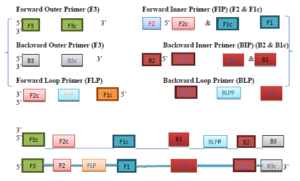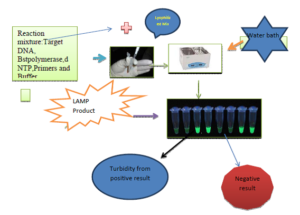Loop-Mediated Isothermal Amplification (LAMP) Assay for detection of gene amplification without use of gel electrophoresis/thermocycler on field conditions
*Mayank kumar agarwal and Narendra singh rathore1
*Department of Veterinary Physiology & Biochemistry, Arawali Veterinary College, Sikar- 332001, Rajasthan, India
1Assistant Professor, Department of Veterinary Biochemistry, College of Veterinary & Animal Science, RAJUVAS, Bikaner-334001, Rajasthan, India
*Corresponding address- mgargupw@gmail.com
Abstract-
Loop-Mediated Isothermal Amplification (LAMP) is the most powerful molecular diagnostic technique. This nucleic gene amplification technique, amplifies nucleic acid at a very rapid pace, maintaining high sensitivity, specificity and efficiency and innovative features of LAMP, is the simplicity of its protocol, and overall low cost of application. Some drawbacks include highly technical and cumbersome primer design protocol, and relative scarcity of materials required for the technique. LAMP was first discovered by Notomi et al. (2000) among isothermal DNA amplification techniques and is said to be rapidly replacing thermocycler based amplification. The technique requires Bst DNA polymerase and a set of four primers recognizing 6-8 regions of target DNA and work best isothermal temp. at 60 °C to 65 °C, to its ability to amplify gene in an unprocessed samples. The PCR and others pre-existing techniques, has contributed immensely in disease diagnosis and molecular biology at large. But, their use in molecular diagnostics is mostly limited to highly resourced establishment or well-equipped laboratory. The cheapness and user-friendliness due to felid based on-spot diagnosis of LAMP, provides diagnostic solution to the odds of PCR and its likes. Other components of LAMP include Deoxynucleoside Triphosphate (dNTP), which provides the required nucleotides, Magnesium Sulphate (MgSO4) forms the pyrophosphate ions, which accumulates in the reaction mixture with samples (Blood, urine, tissues etc.) to form visible white precipitate. Fluorescent DNA dye (SYBR Green, HNB, Picogreen and Calcein) can be added to ease the naked eye visualization of the turbidity or colour resulting from precipitate of pyrophosphate ions. Presently several forms of LAMP kits, such as Lyophilized LAMP Kit, electric LAMP device (eLAMP), and combined use of LAMP and Lateral Flow Assay (LFA), are been adopted for diagnosis of many pathogens or diseases.
Keywords: Real Time-Polymerase Chain Reaction (RT-PCR), Forward inner primer (FIP), Backward/reverse inner primer (BIP) and Deoxynucleoside Triphosphate (dNTP)
Introduction-
Development of a novel gene amplification technique called Loop-Mediated Isothermal Amplification (LAMP), promises to fill those gaps in molecular diagnostics. LAMP was first discovered by Notomi et al. (2000) among isothermal DNA amplification techniques and is said to be rapidly replacing thermocycler based amplification. It is a single tube technique that amplifies few copies of DNA into billion copies within an hour. It is a very rapid, sensitive and efficient nucleic acid amplification technique1. The robustness of LAMP as a novel technique, has been proven in various work carried out with outstanding results which eliminates the odds of the PCR and pre-existing molecular techniques (Table-1).
These wonderful properties of LAMP gives room for its application both in resourced and resource limited settings, only a simple water bath is needed for a complete round of test, unlike other conventional methods that require sophisticated instrument, such as PCR thermo cycler. Although LAMP is a technically sound technique, it is however simple to perform due to its straightforward principles, a semiskilled personnel can effectively perform the assay, and protocols are comprehensive with no sophisticated instruments required. The reaction is rapidly and efficiently conducted in a single step, hence, an ideal point of care diagnostic tool (POCT).
This high specificity reflects on the strict adherence of the 4-6 LAMP primers which hybridizes to six or eight distinct regions of a target gene and work best isothermal temp. at 60 °C to 65 °C.
The LAMP method required the utilization of four sets of primers, two outer (F3 and B3) and two inner (forward inner primer (FIP) and reverse inner primer (BIP) primers, which recognized six distinct regions of the target sequence (F1, F2, F3, B1, B2, and B3) (Figure-1). The primers were designed using the online software Primer Explorer (http://primerexplorer.jp/elamp4.0.0/index.html, Eiken Chemical Co., Ltd., Japan).
Chemical called Betaine is used in stabilization of the AT and GC content, to ensure stability of the reaction. Other components include Deoxynucleoside Triphosphate (dNTP), which provides the required nucleotides, Magnesium Sulphate (MgSO4) forms the pyrophosphate ions, which accumulates in the reaction mixture to form visible white precipitate. Fluorescent DNA dye can be added in the samples to ease the visualization of the turbidity resulting from precipitate of pyrophosphate ions. Example of DNA dyes used in LAMP include SYBR Green, HNB (Hydroxy naphthol blue), Picogreen and Calcein metal ion indicator.
|
|
Conclusion-
If all the components required for LAMP reaction are available, the assay can be accomplished within an hour. As a single tube technique, the reaction proceeds in a direct step which involves mixing of all that is required to perform the assay in a single tube. The reaction mixture consists of samples (blood, urine, tissues etc.), primers, dNTPs, LAMP Buffer solution, Betaine (Optional), Fluorescent DNA dye (optional) and Template DNA. The reaction mixture is then incubated under isothermal temperature of 60°C-65°C. excluding the template extraction step, the process last for about an hour when using four primers for amplification. However, amplification with six primers which includes two loop primers speeds up the reaction process, this shortens the amplification time to about 30 minutes. Following incubation of the reaction mixture, the result is detected immediately without any extra step. This is achieved through naked eye visualization of the turbidity resulting from a positive reaction (Figure-2). Visualization of the LAMP can be simplified by addition of DNA dye viz. calcein HNB etc. to enhance the visibility of the turbidity. Example of such dye is the SYBR green DNA dye, this changes the colour of the mixture into green, indicating a positive result. Other dyes that can be used include HNB, Picogreen, ethidium bromide and Calcein metal ion indicator. So, fluorescent DNA dye based LAMP reaction can be easily visualized through naked eyes on field conditions with limited sources and identified animal diseases on field quickly.
Table- 1: Comparative advantages of LAMP and most common conventional methods
| Properties | LAMP | PCR | RT-PCR |
| Amplification within 1 hour | Yes | No | No |
| Sensitive technique | Yes | Yes | Yes |
| Single step technique | Yes | No | Yes |
| Can amplify without template extraction | Yes | No | No |
| Simple/Inexpensive amplification device | Yes | No | No |
References-
- Abdullahi, U.F., Naim, R., Taib, W.R.W., Saleh, A., Muazu, A., Aliyu, S. and Baig A. (2015). Loop-mediated isothermal amplification (LAMP), an innovation in gene amplification: bridging the gap in molecular diagnostics; a review. Indian Journal of Science and Technology. 8(17):1.
- Notomi T, Okayama H, Masubuchi H, Yonekawa T, Watanabe K, Amino N and Hase T (2000). Loop-mediated isothermal amplification of DNA. Nucl Acids Res; 28:e63.
- Liu, J., Shi, Y., Teng, S., Wu, L. and Zhang, X. (2017). Establishment and Evaluation of a Loop-Mediated Isothermal Amplification Assay for Detection of Raccoon Dog in Meat Mixtures. Journal of Food Quality.
- Parida M, Sannarangaiah S, Dash PK, Rao PVL and Morita K (2008). Loop Mediated Isothermal Amplification (LAMP): A new generation of innovative gene amplification technique; perspectives in clinical diagnosis of infectious diseases. Rev Med Virol; 18:407–21.





